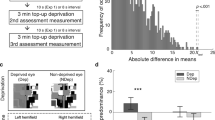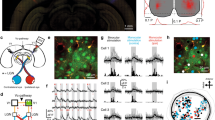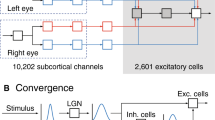Abstract
Visual experience begins at eye opening, but current models consider cortical circuitry to be resistant to experience-dependent competitive modification until the activation of a later critical period. Here we examine this idea using optical imaging to map the time course of receptive field refinement in normal mice, mice in which the contralateral eye never opens and mice in which the contralateral eye is silenced. We found that the refinement of ipsilateral eye retinotopy is retarded by contralateral deprivation, but accelerated by silencing of the contralateral eye. Patterned visual experience through the ipsilateral eye is required for this acceleration. These differences are most obvious at postnatal day 15, long before the start of the critical period, indicating that experience-dependent binocular plasticity occurs much earlier than was previously thought. Furthermore, these results suggest that the quality of activity, in terms of signal to noise, and not the quantity, determines robust receptive field development.
This is a preview of subscription content, access via your institution
Access options
Subscribe to this journal
Receive 12 print issues and online access
$209.00 per year
only $17.42 per issue
Buy this article
- Purchase on Springer Link
- Instant access to full article PDF
Prices may be subject to local taxes which are calculated during checkout






Similar content being viewed by others
References
Hubel, D.H. & Wiesel, T.N. The period of susceptibility to the physiological effects of unilateral eye closure in kittens. J. Physiol. (Lond.) 206, 419–436 (1970).
Gordon, J.A. & Stryker, M.P. Experience-dependent plasticity of binocular responses in the primary visual cortex of the mouse. J. Neurosci. 16, 3274–3286 (1996).
Issa, N.P., Trachtenberg, J.T., Chapman, B., Zahs, K.R. & Stryker, M.P. The critical period for ocular dominance plasticity in the Ferret's visual cortex. J. Neurosci. 19, 6965–6978 (1999).
Olson, C.R. & Freeman, R.D. Profile of the sensitive period for monocular deprivation in kittens. Exp. Brain Res. 39, 17–21 (1980).
Huang, Z.J. et al. BDNF regulates the maturation of inhibition and the critical period of plasticity in mouse visual cortex. Cell 98, 739–755 (1999).
Fagiolini, M. & Hensch, T.K. Inhibitory threshold for critical-period activation in primary visual cortex. Nature 404, 183–186 (2000).
Fagiolini, M. et al. Specific GABAA circuits for visual cortical plasticity. Science 303, 1681–1683 (2004).
Crair, M.C., Gillespie, D.C. & Stryker, M.P. The role of visual experience in the development of columns in cat visual cortex. Science 279, 566–570 (1998).
White, L.E., Coppola, D.M. & Fitzpatrick, D. The contribution of sensory experience to the maturation of orientation selectivity in ferret visual cortex. Nature 411, 1049–1052 (2001).
Pettigrew, J.D. The effect of visual experience on the development of stimulus specificity by kitten cortical neurones. J. Physiol. (Lond.) 237, 49–74 (1974).
Sherk, H. & Stryker, M.P. Quantitative study of cortical orientation selectivity in visually inexperienced kitten. J. Neurophysiol. 39, 63–70 (1976).
Ruthazer, E.S. & Stryker, M.P. The role of activity in the development of long-range horizontal connections in area 17 of the ferret. J. Neurosci. 16, 7253–7269 (1996).
Crowley, J.C. & Katz, L.C. Development of ocular dominance columns in the absence of retinal input. Nat. Neurosci. 2, 1125–1130 (1999).
Crowley, J.C. & Katz, L.C. Early development of ocular dominance columns. Science 290, 1321–1324 (2000).
Wallace, W. & Bear, M.F. A morphological correlate of synaptic scaling in visual cortex. J. Neurosci. 24, 6928–6938 (2004).
Lu, W. & Constantine-Paton, M. Eye opening rapidly induces synaptic potentiation and refinement. Neuron 43, 237–249 (2004).
Maffei, A., Nelson, S.B. & Turrigiano, G.G. Selective reconfiguration of layer 4 visual cortical circuitry by visual deprivation. Nat. Neurosci. 7, 1353–1359 (2004).
Tagawa, Y., Kanold, P.O., Majdan, M. & Shatz, C.J. Multiple periods of functional ocular dominance plasticity in mouse visual cortex. Nat. Neurosci. 8, 380–388 (2005).
Li, Y., Fitzpatrick, D. & White, L.E. The development of direction selectivity in ferret visual cortex requires early visual experience. Nat. Neurosci. 9, 676–681 (2006).
Kalatsky, V.A. & Stryker, M.P. New paradigm for optical imaging: temporally encoded maps of intrinsic signal. Neuron 38, 529–545 (2003).
Taha, S., Hanover, J.L., Silva, A.J. & Stryker, M.P. Autophosphorylation of alphaCaMKII is required for ocular dominance plasticity. Neuron 36, 483–491 (2002).
Cang, J. et al. Development of precise maps in visual cortex requires patterned spontaneous activity in the retina. Neuron 48, 797–809 (2005).
Godement, P., Salaun, J. & Imbert, M. Prenatal and postnatal development of retinogeniculate and retinocollicular projections in the mouse. J. Comp. Neurol. 230, 552–575 (1984).
Chapman, B. Necessity for afferent activity to maintain eye-specific segregation in ferret lateral geniculate nucleus. Science 287, 2479–2482 (2000).
Chapman, B., Jacobson, M.D., Reiter, H.O. & Stryker, M.P. Ocular dominance shift in kitten visual cortex caused by imbalance in retinal electrical activity. Nature 324, 154–156 (1986).
Song, S., Miller, K.D. & Abbott, L.F. Competitive Hebbian learning through spike-timing-dependent synaptic plasticity. Nat. Neurosci. 3, 919–926 (2000).
Hensch, T.K. Critical period plasticity in local cortical circuits. Nat. Rev. Neurosci. 6, 877–888 (2005).
Miller, K.D., Keller, J.B. & Stryker, M.P. Ocular dominance column development: analysis and simulation. Science 245, 605–615 (1989).
Feldman, D.E. Timing-based LTP and LTD at vertical inputs to layer II/III pyramidal cells in rat barrel cortex. Neuron 27, 45–56 (2000).
Chang, E.F. & Merzenich, M.M. Environmental noise retards auditory cortical development. Science 300, 498–502 (2003).
Weliky, M. & Katz, L.C. Disruption of orientation tuning in visual cortex by artificially correlated neuronal activity. Nature 386, 680–685 (1997).
Zhou, Q., Tao, H.W. & Poo, M.M. Reversal and stabilization of synaptic modifications in a developing visual system. Science 300, 1953–1957 (2003).
Vereecken, E.P. & Brabant, P. Prognosis for vision in amblyopia after the loss of the good eye. Arch. Ophthalmol. 102, 220–224 (1984).
Isenberg, S.J. Amblyopia can be treated without occlusion or atropine. Ophthalmology 113, 893 (2006).
Acknowledgements
We thank M. Stryker for suggesting the APB experiments and for helping to troubleshoot our imaging setup; E. Ruthazer for providing us with his enucleation protocol; and A. McGee, W. Thompson, J. Faguet, E. Ruthazer and M. Stryker for critically reading the manuscript. This work was supported by the US National Eye Institute, the Klingenstein Foundation and the Giannini Family Foundation.
Author information
Authors and Affiliations
Contributions
S.L.S. conducted the experiments, wrote the computer code for image acquisition and analysis, conducted the data analyses and prepared the figures. J.T.T. conducted some of the experiments and supervised the project. S.L.S. and J.T.T. contributed equally to writing the manuscript.
Corresponding author
Ethics declarations
Competing interests
The authors declare no competing financial interests.
Rights and permissions
About this article
Cite this article
Smith, S., Trachtenberg, J. Experience-dependent binocular competition in the visual cortex begins at eye opening. Nat Neurosci 10, 370–375 (2007). https://doi.org/10.1038/nn1844
Received:
Accepted:
Published:
Issue Date:
DOI: https://doi.org/10.1038/nn1844
This article is cited by
-
Arousal state transitions occlude sensory-evoked neurovascular coupling in neonatal mice
Communications Biology (2023)
-
Rehabilitation of visual functions in adult amblyopic patients with a virtual reality videogame: a case series
Virtual Reality (2023)
-
Flexible cue anchoring strategies enable stable head direction coding in both sighted and blind animals
Nature Communications (2022)
-
Mdm1 ablation results in retinal degeneration by specific intraflagellar transport defects of photoreceptor cells
Cell Death & Disease (2022)
-
Portrait of visual cortical circuits for generating neural oscillation dynamics
Cognitive Neurodynamics (2021)



